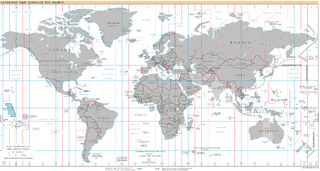
The Line Islands, Teraina Islands or Equatorial Islands are a chain of 11 atolls and coral islands in the central Pacific Ocean, south of the Hawaiian Islands. Eight of the atolls are parts of Kiribati. The remaining three—Jarvis Island, Kingman Reef, and Palmyra Atoll—are territories of the United States grouped with the United States Minor Outlying Islands. The Line Islands, all of which were formed by volcanic activity, are one of the longest island chains in the world, stretching 2,350 km (1,460 mi) from northwest to southeast. One of them, Starbuck Island, is near the geographic center of the Pacific Ocean. Another, Kiritimati, has the largest land area of any atoll in the world. Only Kiritimati, Tabuaeran, and Teraina have a permanent population. Besides the 11 confirmed atolls and islands, Filippo Reef is shown on some maps, but its existence is doubted.

A time zone is an area which observes a uniform standard time for legal, commercial and social purposes. Time zones tend to follow the boundaries between countries and their subdivisions instead of strictly following longitude, because it is convenient for areas in frequent communication to keep the same time.

The International Date Line (IDL) is the line between the South and North Poles that is the boundary between one calendar day and the next. It passes through the Pacific Ocean, roughly following the 180.0° line of longitude and deviating to pass around some territories and island groups. Crossing the date line eastbound decreases the date by one day, while crossing the date line westbound increases the date.

UTC−11:00 is an identifier for a time offset from UTC of −11:00. This time is used in Niue, American Samoa, Swains Island, and parts of the United States Minor Outlying Islands. This is the latest inhabited time zone, meaning this is the last inhabited time zone to celebrate the New Year, as the world's latest time zone (UTC-12:00) is completely uninhabited.

UTC+12:00 is an identifier for a time offset from UTC of +12:00.

UTC+14:00 is an identifier for a time offset from UTC of +14:00. This is the earliest time zone on Earth, meaning that areas in this zone are the first to see a new day, and therefore the first to celebrate a New Year. It is also referred to as the "latest time zone" on Earth, as clocks in it always show the 'latest' time of all time zones.

Time in Brazil is calculated using standard time, and the country is divided into four standard time zones: UTC−02:00, UTC−03:00, UTC−04:00 and UTC−05:00.
Samoa uses UTC+13:00 as standard time. Until the end of 2011, it used UTC−11:00 as standard time. Samoa observed daylight saving time from 2010 to 2021.

Georgia Time (GET) is a time zone used in Georgia and it is uniform throughout the country. It moved from zone UTC+04:00 to UTC+03:00 on 27 June 2004, then back to UTC+04:00 on 27 March 2005. Georgia has not observed daylight saving time since 2004.

Severe Tropical Storm Zelda was the last tropical cyclone of the 1991 Pacific typhoon season; it struck the Marshall Islands on November 28. The area of low pressure that eventually became Zelda formed near the International Date Line, and strengthened into a tropical depression on November 27. The Joint Typhoon Warning Center (JTWC) reported that the depression had reached tropical storm intensity near the Marshall Islands on November 28, thus naming it Zelda. On November 29, the storm quickly strengthened to 65 knots according to the JTWC, equivalent to a Category 1 typhoon on the Saffir–Simpson hurricane wind scale. It reached a peak of 80 kn according to the JTWC, and 60 kn according to the Japanese Meteorological Agency (JMA), with a barometric pressure of 975 hectopascals (28.8 inHg). Zelda weakened into a tropical storm on December 2, and then a tropical depression two days later. The JTWC discontinued warnings late on December 4, while the JMA declared the storm to be extratropical the next day and continued to track until it crossed the International Date Line again on December 7.
Time in Tuvalu is given by Tuvalu Time. Tuvalu Time does not have an associated daylight saving time.
Time in Vanuatu is given by Vanuatu Time. Vanuatu does not currently observe daylight saving time. Vanuatu previously observed DST (UTC+12:00) between 1 September 1983 until 1993.
Time in Palau is given by Palau Time. Palau does not have an associated daylight saving time.
In Sweden, the standard time is Central European Time. Daylight saving time is observed from the last Sunday in March to the last Sunday in October. Sweden adopted CET in 1900.
Kiribati, a country in Oceania comprising 32 atolls and reef islands and one raised coral island, observes three time zones, ranging from UTC+12:00 to +14. Kiribati does not observe daylight saving time.
Time in Solomon Islands is given by Solomon Islands Time. Solomon Islands does not have an associated daylight saving time.
Time in Nauru is given by Nauru Time, also known infrequently as "Nauru Alternate Time". Nauru does not have an associated daylight saving time.
The Federated States of Micronesia, a country in Oceania consisting of around 607 islands, observes two time zones, UTC+10:00 in its western part, and UTC+11:00 in its eastern part. Micronesia does not have an associated daylight saving time.
In Slovenia, the standard time is Central European Time. Daylight saving time is observed from the last Sunday in March to the last Sunday in October. This is shared with several other EU member states.

In Romania, the standard time is Eastern European Time. Daylight saving time, which moves one hour ahead to UTC+03:00 is observed from the last Sunday in March to the last Sunday in October.








